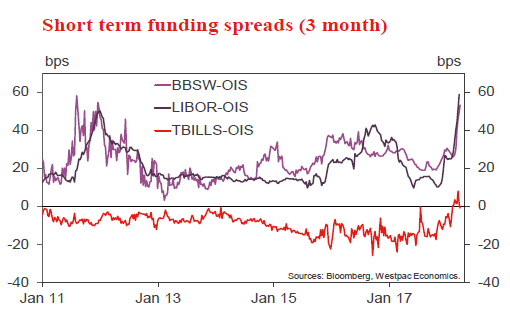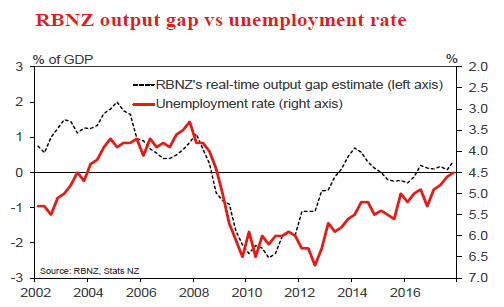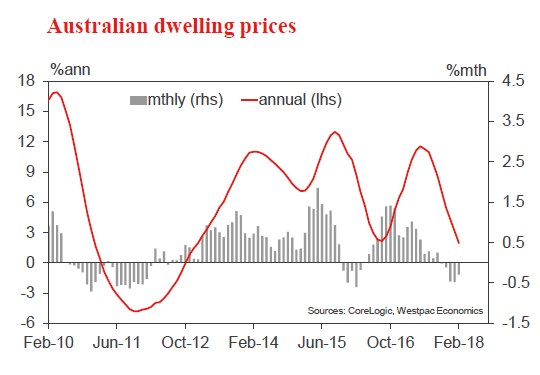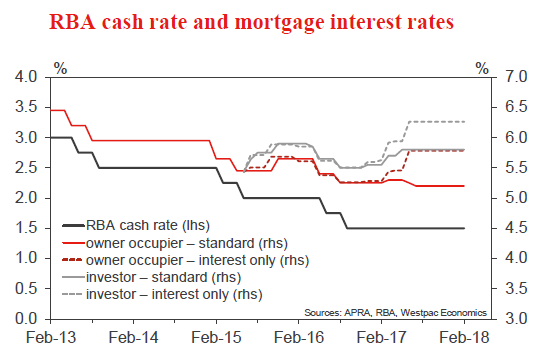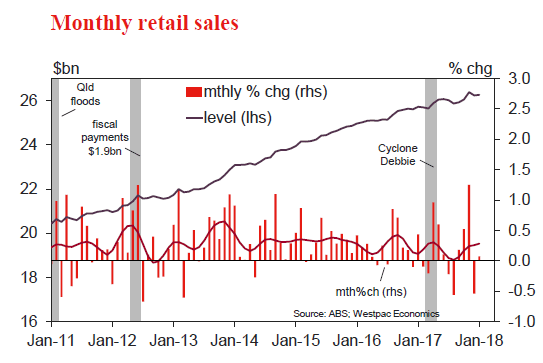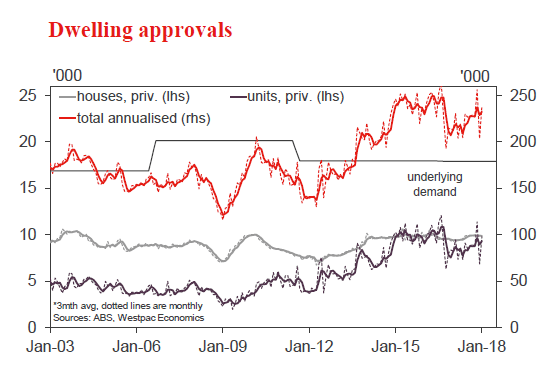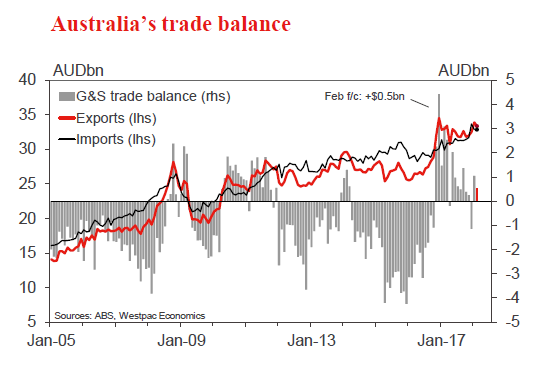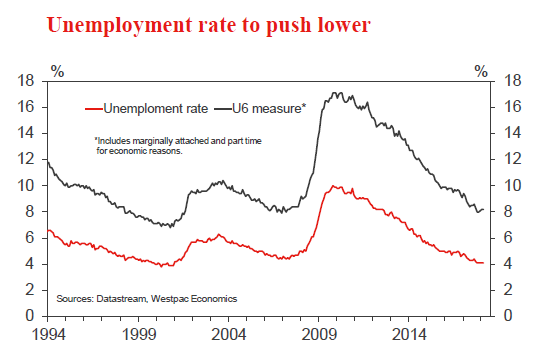Week beginning 2 April 2018
- RBA on hold; economic and financial developments further support steady rates in Australia.
- Australia: RBA decision, retail sales, dwelling approvals, trade balance, house prices.
- NZ: QVNZ house prices.
- China: Caixin PMIs.
- Euro Area: CPI, unemployment rate.
- US: nonfarm payrolls, ISM PMIs.
- Key economic & financial forecasts.
Information contained in this report current as at 29 March 2018.
RBA on hold; economic & financial developments in 2018 further support steady rates in Australia.
The Reserve Bank Board next meets on April 3. There is almost certain to be no rate move coming from that meeting.
Market Pricing and Analysts Forecasts
Market pricing for the RBA has moved significantly over the last six months.
Last September markets were predicting nearly two rate hikes by end 2018. Now markets have pushed these “nearly two rate hikes” back to 2019 with only around a 40% chance of any move by the end of 2018. The first of these hikes is fully priced in by mid-year and the second in the second half of the year.
Economists’ forecasts have also been shifting.
Thirteen major banks/ investment banks contribute to the regular Bloomberg Survey. Back in September seven expected rate hikes by the third quarter of 2018 and six expected rates to be on hold.
Recall that throughout 2017 Westpac has had the “outrageous” call that the RBA would be on hold through 2017; 2018; and 2019.
The latest Bloomberg Survey sees considerable changes in the economists’ views. Only one of the thirteen continue to expect a hike by the third quarter of this year but eight others are anticipating a move by the first quarter of 2019. Only four, including Westpac, expect rates to be on hold through the first quarter. We cannot be sure when the other three are expecting the first move as the survey only extends to the first quarter.
A range of recent developments is easing concerns about the need for the RBA to raise rates.
Emerging Trends in the Labour Market
The labour market has always been seen as the “star performer” for the economy. But jobs growth is slowing. The pace of jobs growth over the last three months has slowed from 3.4% over the course of 2017 to 2.1% (three month annualised). Furthermore, the unemployment rate, which fell from 5.9% to 5.5% by September has stabilised, printing 5.6% in February.
Westpac concurs with around a 2.0% pace of employment growth over the course of the remainder of 2018. Associated with a modest further rise in the participation rate we expect the unemployment rate to remain around current levels. With the “full employment” rate assessed as being around 5%, considerable “slack” is expected to remain in the Australian economy over 2018.
Recently the modest fall in the underemployment rate has stalled with the rate actually rising from 8.3% to 8.4% over the last three months.
Developments in Housing Markets
Most housing markets have peaked. Over the last three months, house prices in Sydney have fallen by 4.2% (annualised) compared to an increase of 3.1% over the last year. For Melbourne and Brisbane house prices have stalled compared to increases over 2017 of 8.9% and 2.4% respectively. With the value proposition for investors in particular appearing to be discouraging (low rental yields; flat prices; increasing regulation and potential tax changes), prospects in the major Australian housing markets are clouded.
Financial Conditions are Tightening
Other asset markets have also been underwhelming. Since the beginning of the year, Australia’s share market has fallen by 4%, including a 7% fall for bank stocks and a 4.7% fall for resources.
Australian banks generally borrow in the short end of the market at BBSW – a rate that last year traded at around 20-25 basis points above the expected RBA overnight cash rate, reflecting “normal” credit risk. That margin has increased to around 50 basis points – effectively an increase in short term funding rates of around 25 basis points or one full RBA rate hike.
That increase in spreads is not due to an assessed widening in bank credit risks. There are other explanations for this development. One important explanation is the recent US tax changes which allow US corporates (in particular the cash rich technology companies) to direct funds (mainly US dollars) back to the US from foreign sources (total funds estimated at around $1.5 trillion without paying the onerous 35% tax rate). Foreign banks, including Australia, which had relied on this USD funding, have had to switch demand for funds to local markets, intensifying rate pressures.
The “shortage” of USD offshore funds has boosted USD funding costs – LIBOR by around 25 basis points.
Most business borrowers will be affected by this increase in BBSW. One small bank even slightly raised its variable mortgage rate to reflect this 25 basis point increase in short term funding costs. This is despite other banks cutting their rates on new lending for some forms of investment loans.
Australian banks have also recently suffered increases in their funding costs in longer maturities with bank 5 year paper lifting by around 15 basis points compared to the risk free rate.
Credit growth has slowed to 3.8% annualised over the three months to February compared with 4.9% growth for 2017. This includes a slowing in housing credit growth from 6.3% in 2017 to 6.0% annualised over the past three months. Business credit stalled over the past three months, with 0.4% annualised growth, in contrast to a 3.2% increase in 2017.
Global Growth may have Plateaued
The positive lift in global growth in 2017 may be fading.
Manufacturing PMI’s stood out in 2017 as signalling strong global growth. However recent developments have been less encouraging. The PMI’s are estimated to have bottomed out around September 2016. The Global manufacturing PMI has moved to 50.4 (September 2016) to 54 (December 2017) back to 53.2 (March). Respectively, Europe (52.6; 60.6; 56.6); US (51.5; 55.5; 55.7); Japan (50.4; 54; 53.2) and China (50.4; 51.6; 50.3).
Trade tensions must be impacting confidence although there remains considerable uncertainty over the extent and timing of President Trump’s trade policies. The 25% and 10% tariffs on steel and aluminium announced at the beginning of March were initially imposed on all countries, but subsequently rolled back to only a few nations, including China, although excluding Europe; Brazil; and Canada (among others). This exemption has been enough to hold the EU back from retaliating to date.
China has quickly become the sole focus of the trade debate. With tariffs to be imposed on around $50bn of imports from China. Just after this announcement, China retaliated with planned tariffs on $3bn of US imports across 128 products.
Our view is that it seems most likely that a compromise will be found between the US, Europe and China. But the animosity and uncertainty will continue to weigh on confidence.
Exchange Rates are also Questioning the Global Outlook
Usually a slowing global environment will weigh on the Australian dollar and support the USD. The Trade Weighted Index for the AUD has fallen from 65.70 end January to 62.60 to date. The Australian dollar has fallen from a recent peak of USD 0.81 in late January to USD 0.773. Furthermore, the USD has stabilised. In 2017, a weaker USD (down around 14%) was associated with strengthening global growth. Since late January, the USD Index has held steady despite considerable market volatility.
Overall developments since the beginning of the year both domestically and globally have strengthened the case for a benign rate outlook in Australia.
The week that was
In a week devoid of top-tier data, trade frictions remained the dominant force for financial markets. The US interest rate curve has flattened as long-dated yields fell, and equities have experienced further declines, taking the S&P500 and NASDAQ back near their early-February lows.
On trade, a lot has been said and done in the past month. So as March ends, a recap is in order.
After many a rumour, President Trump’s initial trade action at the beginning of March was to impose universal 25% and 10% tariffs on steel and aluminium imports to the US. The breadth of the measure received considerable attention, but concern quickly faded as the biggest exporters of steel, the EU; Brazil; and Australia among others, as well as Canada and Mexico were granted exemptions. This decision emphasized (unsurprisingly) that China is the focus of the trade debate in the US. (Note on steel and aluminium, a caveat applies: the exemption granted by President Trump is ‘temporary’ pending negotiations; hence uncertainty remains.)
As we noted in the last edition of Cliff Notes, President Trump has since upped the anti against China, announcing a focused threepart trade policy. Included were tariffs on around $50bn of (yet to be confirmed) US imports from China; a request for the Treasury Secretary to draft new investment restrictions for Chinese firms who wish to invest in the US; and the bringing of a WTO complaint against China for discriminatory licensing practices.
China has since retaliated against the US, announcing tariffs on $3bn of US imports across 128 products. Most notable in this action however is that Chinese authorities made clear it was a targeted response to the initial steel tariff only; further, their introduction is to be delayed until the US and China can hold negotiations. This is very clear evidence of China seeking a diplomatic solution.
China’s reserve is not because they lack power. To the contrary, they have scope to introduce wide-ranging tariffs, and tightly control who can make investments in their domestic economy. While given less press, China also has the capacity to affect US borrowing costs, being the largest foreign holder of US Treasury securities.
With this is mind, it is arguably best to regard further reports of the US imposing investment restrictions on Chinese firms wanting to invest in the US as a bargaining chip. National security is certainly an issue for the US in niche sectors; however, the opportunity to engage with China and open up opportunities for US firms to invest is not one to be missed.
Our overall view on the current trade frictions is that a compromise will eventually be found between the US and China, and that Europe will also be kept on side. However, this could take a long time. In the meantime, financial markets are likely to face continued uncertainty and hence volatility.
For US monetary policy, while trade relations are a risk that warrant close attention, as it stands the FOMC’s gradual interest rate hike cycle won’t be delayed or stopped. As above, uncertainty looks to have halted the rise in term interest rates in the US, while the US dollar is only a few percentage points above its 2018 low. Financial conditions facing the US economy are therefore very positive. Available information also points to consumer and business confidence remaining robust, supporting the forward view for consumption and business investment.
Speaking of sentiment, the release of Euro Area confidence data this week has highlighted that, while headline sentiment is strong, households are likely to pull back on spending during 2018. The reason being that, in recent years, pent-up demand has been released with the aid of consumer credit and dissaving. Going forward, spending growth is likely to come back into line with income growth. We and the ECB still anticipate that GDP growth will remain above potential, allowing the Governing Council to raise interest rates gradually in 2019 and 2020. But there is a risk that consumers pull back more aggressively and/ or businesses revert to their past default of financial and operational efficiency – eschewing increases in investment and employment.
Closer to home, this week also saw the release of New Zealand’s new Policy Targets Agreement for the RBNZ. Greater weight will be given to employment, both with respect to the RBNZ’s decision making and their communications on the economy. However, inflation remains the focus for policy setting.
Notably the 2.0%yr mid-point for the 1-3%yr inflation range was kept, and will remain the prime benchmark for policy. A procedural change was also made, with a policy Committee to replace the current singular decision making of the RBNZ Governor. The Committee will be made up of five to seven members, with external members the minority. Treasury will be limited to a nonvoting observer. However, the Minister of Finance will have a more regular opportunity to alter the structure of the Committee through the appointment of Committee members as well as the Governor. Further, the Minister of Finance will also now determine the operational objectives of the Committee, such as the inflation target, unilaterally rather than with the Governor. Advice on changes has to be sought from the Treasury and RBNZ, but not necessarily followed.
Chart of the week: Short term funding spreads
.As mentioned in the weekly essay on the previous page, short term funding spreads have widened significantly over the recent month or so.
The chart to the right shows: a) TBILLS-OIS 3m spread – US treasury bill minus the market expected overnight fed funds rate; b) LIBOR-OIS 3m spread – LIBOR (USD bank funding) minus the market expected overnight fed funds rate; and c) BBSW-OIS 3m spread – BBSW (AUD bank funding) minus the market expected overnight RBA cash rate.
When the spike in rates begun, the three spreads moved in unison higher. Notably in the past few days, the treasury bill spread has edged back in while the bank funding spreads remain elevated.
New Zealand: week ahead & data wrap
Dual meaning
This week brought the long-awaited details of the new Government’s planned reforms to the monetary policy framework. Incoming RBNZ Governor Adrian Orr signed an agreement with the Minister of Finance that included a revised set of policy targets. The Minister also detailed changes to the RBNZ’s decision-making structure, which will take effect next year.
The RBNZ’s policy objectives have been expanded to include not just price stability, but also a contribution to supporting maximum sustainable employment. This is along the lines of the ‘dual mandates’ seen in Australia and the US.
In terms of its policy targets, the RBNZ will continue to aim for future inflation of 1-3% over the medium term, with a focus on keeping inflation near the 2% midpoint. Retaining the focus on the midpoint was not guaranteed, and its removal might have signalled an intention to let inflation run hotter in coming years.
The new employment objective does not include a numerical target, and the phrasing of maximum ‘sustainable’ employment allows the RBNZ to respond in a symmetrical way to variations around a long-run natural rate. The RBNZ will also be required to explain how its actions are contributing to supporting maximum sustainable employment, but will not be held solely accountable for labour market outcomes.
Our view is that, in current circumstances, the introduction of the employment objective will make little difference to the RBNZ’s behaviour. Today’s unemployment rate of 4.5% is around what most would consider to be a sustainable long-run rate. Inflation is within the target range (albeit on the lower side), and the RBNZ is forecasting it to stay there. And the RBNZ already has a great deal of flexibility around how it manages the path of inflation over the medium term.
That said, there may be circumstances in the future where the employment objective does make a difference to the RBNZ’s interest rate decisions. Arguably, there have been times in the past when a dual mandate might have made a difference as well – the Finance Minister has for instance mentioned the 2014 episode, when the RBNZ raised the cash rate by 100 basis points in anticipation of a rise in inflation, only to start reversing those hikes a year later.
At the time, the RBNZ believed that the economy was running above its non-inflationary potential. With the benefit of more historical data, the RBNZ now estimates that output was still below potential in 2014. A focus on the labour market might have brought the RBNZ to the right conclusion sooner: the unemployment rate was around 5.5% at the time, which is consistent with some spare capacity remaining.
However, the RBNZ is a forward-looking inflation targeter, and focuses on how inflation pressures are expected to develop over the medium term. While the unemployment rate may have been on the high side in 2014, the RBNZ was forecasting a return to full employment over the next few years, which would have been associated with a pickup in wage and price pressures. So it’s far from clear that a focus on employment would have prevented the 2014 rate hikes, although the RBNZ might have been less aggressive in signalling future rate hikes – initially it expected that it would need to hike the OCR by at least 200 basis points over two years.
In addition to the new policy targets, the Minister of Finance announced a change in how the RBNZ determines monetary policy. Currently, New Zealand operates a single decision-maker model, where the Governor has sole authority for setting the OCR. From 2019, monetary policy will be set by a committee of five to seven members. This will be made up of a majority of RBNZ internal members and a minority of external members. There will also be a non-voting Treasury observer. External members will be appointed by the Minister of Finance on the recommendation of the Board for four-year terms, while internal members will be appointed the same way but for staggered fiveyear terms. This will be a voting committee, with a non-attributed vote count and non-attributed minutes of the meetings to be published.
These changes strike a nice balance, drawing on the benefits of group decision-making while avoiding some of the potential pitfalls. The evidence suggests that groups make better decisions than individuals on average. However, attributed comments and votes could have impeded free and frank discussion among the group. In addition, allowing all members of the committee to speak publicly about the policy outlook has at times sent confusing and contradictory signals to markets in the US and UK. The RBNZ will avoid this by making the Governor the only spokesperson for the committee.
The direction of the changes to the monetary policy framework was well-signalled by the new Government, with only the details missing up until now. We have not altered our outlook for the OCR as a result of these changes – we think the RBNZ already has good reason to keep interest rates low for a considerable time. Our forecast remains for the OCR to rise only in late 2019, later than markets anticipate.
Data Previews
Aus Mar CoreLogic home value index
Apr 3, Last: -0.3%, WBC f/c: -0.2%
The weak finish to 2017 for Australia’s housing markets extended into early 2018. The CoreLogic home value index, covering the eight major capital cities, dipped another 0.3% in Feb to be down 1.3% since Oct. Annual price growth slowed to 2%, from a peak of 11.5% in May and dipping below the previous low in Sep 2016 to be the weakest pace since 2012.
The daily index points to further price slippage in March and a 0.2% decline nationally. That would see annual growth dip to below 1%. While there are some hints in the monthly profile that the pace of price declines is moderating, they are far from convincing. The regional detail continues to show a sharper slowdown in Sydney and to a lesser extent Melbourne, both of which had shown much stronger price gains through the upswing. Notably, the milder slowdown in Melbourne looks to have accelerated somewhat in early 2018.
Aus RBA policy decision
Apr 3, Last: 1.50%, WBC f/c: 1.50%
Mkt f/c: 1.50%, Range: 1.50% to 1.50%
The RBA will almost certainly hold rates unchanged at its April meeting – as they have since they last cut rates in Aug 2016.
Attention will again focus on the Governor’s decision statement. In March this reiterated the central line that: “further progress in reducing unemployment and having inflation return to target is expected, although this progress is likely to be gradual”. The Governor sounded a little more confident about the outlook for wages growth which “appears to have troughed”. However, other comments in the statement and the meeting minutes suggest the Bank may be less confident about its 3¼% growth forecast for 2018. The next official update to the Bank’s forecasts is in the May Statement on Monetary Policy. This shift in language – if sustained in April – could be seen as paving the way for a downward revision. Either way, Westpac expects slower growth of 2.7% this year and the cash rate unchanged at 1.5% throughout this year and next.
Apr 4, Last: 0.1%, WBC f/c: 0.4%
Mkt f/c: 0.3%, Range: 0.2% to 0.7%
Retail sales posted a disappointing start to 2018 with a 0.1% gain in Jan only partially retracing a 0.5% decline in Dec which in turn followed a solid rebound in Oct-Nov from a weak Q3. Annual growth slowed to a sub-par 2.1%yr. The subdued result comes despite a firmer backdrop for consumer sentiment and suggests the step-up in price competition associated with the launch of Amazon’s Australian retail operations late last year remains a restraining factor on nominal sales.
Retailers may have fared a little better in Feb. While price competition remains fierce and consumer sentiment softened a touch, retail sector responses to the NAB business survey showed a lift in conditions over Jan-Feb to the second highest reading since late 2015. However, the AiG PSI points to much weaker conditions for retail. On balance we expect Feb to show a 0.4% gain. Note that the survey should include Amazon Australia’s retail sales.
Apr 4, Last: 17%, WBC f/c: -4.0%
Mkt f/c: -5.0%, Range: -12.0% to -1.0%
The January dwelling approvals report came in well above expectations with a 17% jump driven, once again, by extreme swings in the lumpy ‘high rise’ segment (+60% in Nov, -47% in Dec and +36% in Jan). Approvals outside of high rise have been more mixed, private detached house approvals down 1.1% but ‘mid rise’ dwellings up about 15%. On a combined basis, total approvals ex high rise were up 2.9% nationally and 7.2%yr.
Housing finance data continues to point to modest gains in non high rise approvals, albeit with the trend showing signs of softening. High rise is much harder to call. Site approvals continue to point to the segment taking another leg lower after the weakening in the first three quarters of 2017. Note also that despite the big lift in Jan, high rise approvals were coming off a very weak Dec read. On balance we expect total approvals to retrace 4% in Feb but clearly extreme monthly volatility puts significant risks around this estimate.
Apr 5, Last: 1.1, WBC f/c: 0.5
Mkt f/c: 0.7, Range: -0.3 to 2.1
Australia’s trade account recorded a surplus of $1.06bn in January as exports lifted 4.3%, boosted by a $0.8bn spike in gold shipments.
For February, the trade surplus is expected to narrow to $0.5bn, impacted by a pull-back in gold exports.
Export earnings are forecast to decline by 1.6%, down $550mn. An expected $0.8bn pull-back in gold is only partially offset by a lift in LNG volumes, on expanding capacity, and a lift in coal shipments.
Imports are expected to be unchanged in the month. A weaker currency, down 1.8% on a TWI basis and 0.8% lower against the US dollar, will see the cost of imports rise. However, we anticipate an offsetting moderation in fuel imports following two particularly strong months.
Apr 6, nonfarm payrolls, last 313k, WBC 170k
Apr 6, unemployment rate, last 4.1%, WBC 4.0%
Nonfarm payrolls employment growth has been particularly strong in recent months. Feb posted a 313k gain, and job gains in the prior two months were also revised up by 54k in total. The three-month average stands at 242k, well up on 2017’s 182k and 2016’s 195k. After such strength, we are due a softer month, and so forecast a 170k gain. We note however that revisions could do the work and allow for another strong outcome above 200k for the month of Mar.
Turning to the household survey, had it not been for a jump in participation in Feb, the unemployment rate would have come down to 4.0%. Continued strength in employment will see the threshold attained and breached in coming months. A quick drop below 4.0% is a risk if participation reverses recent gains as employment holds up.




